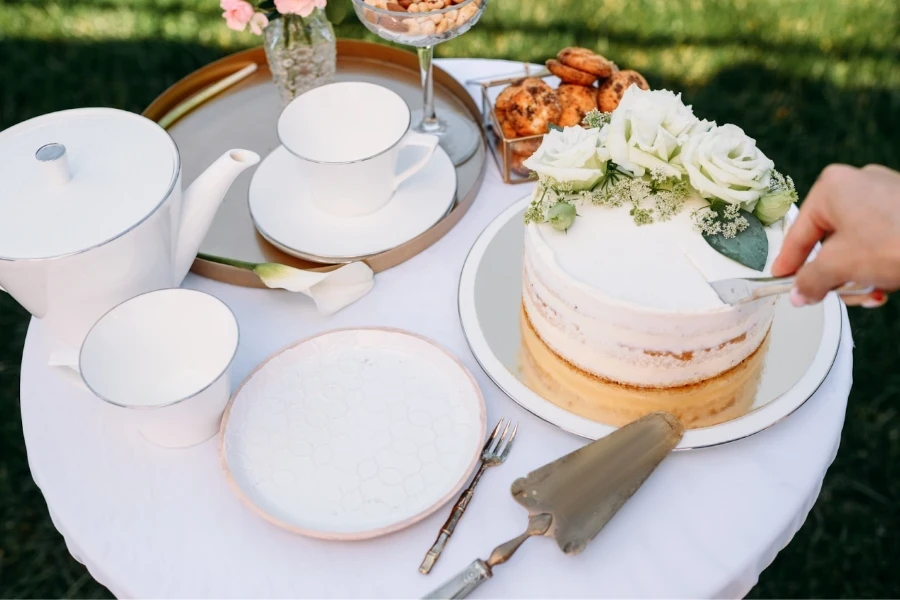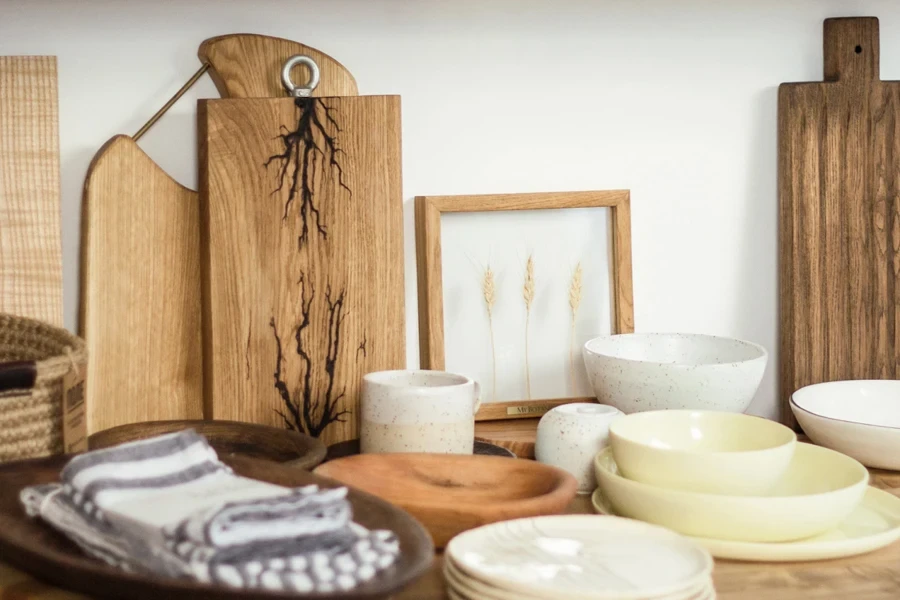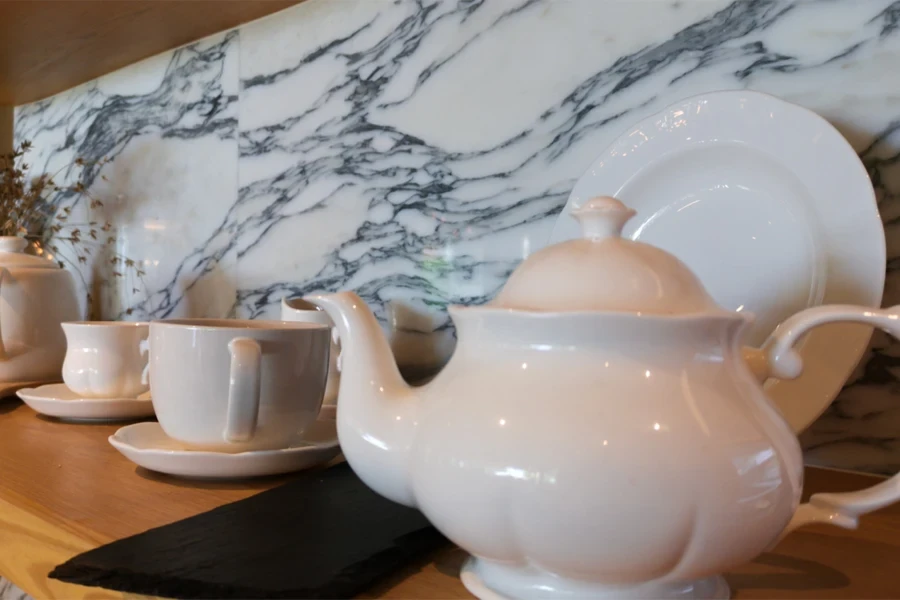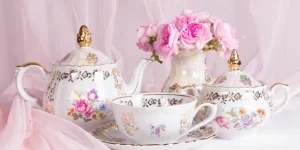Teacup sets are making waves for all the right reasons. Aside from being accessories that give tea drinkers convenience, they boost the whole tea-drinking experience. Another highlight of teacup sets is how they offer consumers a taste of tea etiquette and elevate the aesthetic value of tableware settings.
Consumers’ well-being isn’t overlooked, as drinking from ceramic teacup sets provides helpful health benefits. With this in mind, sellers can make the most of this niche by selecting profitable sets. But first, let’s dive into the market overview for a clearer picture.
Table of Contents
How fast will the teacup market grow?
What to consider when choosing teacup sets for a soothing consumer experience
Wrapping up
How fast will the teacup market grow?
Teacups constitute a major segment of the drinkware market. According to reports, the drinkware market accumulated US $36.10 billion in 2023, with projections estimating it will readjust to US $51.48 billion by 2030. Experts also say the market will reach its new value at a 5.2% compound annual growth rate (CAGR) from 2024 to 2030.
The parent market (drinkware) owes its growth to shifting consumer preferences, growing disposable income, urbanization/lives always on the go, customization/personalization of drinkware, social media influence, increasing environmental awareness, and trends in health and wellness. Another report shows that teacups and mugs registered the most sales, with a value of over US $20 billion in 2022.
What to consider when choosing teacup sets for a soothing consumer experience
Size

Teacup sizes go beyond determining capacity—they also impact the tea’s taste quality. It’s no secret that smaller cups concentrate the tea’s flavors, encouraging consumers to savor each sip and appreciate the nuances. Contrarily, larger cups can dilute the taste—while not generally bad, it may be unsatisfactory for some tea enthusiasts.
Also, some teas are better suited to certain sizes. While black teas can handle more volume, delicate teas like Japanese green tea shine in smaller vessels. Remember that it’s not all about capacity but rather the kind of experience consumers will get from their teacup sets. With that said, here are the different sizes sellers must ensure they have in their teacup sets.
| Teacup size | Capacity (approx.) | Tea experience |
| Gongfu cup | 20 to 50 ml | Small, focused sips to fully appreciate flavor nuances. This size is also ideal for high-quality multi-infusion teas. |
| Tasting cup | 80 to 100 ml | Slightly larger but still emphasizes small volumes. For this reason, this size is great for a variety of teas. |
| Standard teacup | 150 to 200 ml | The traditional size for everyday tea drinking. |
| Mug | 250+ ml | It has a generous capacity, which is good for longer tea sessions where consumers don’t want to refill constantly. However, it’s less ideal for appreciating delicate flavors. |
Shapes

Teacups always have an aesthetic element, making amazing decorative sets if consumers choose to leave them out. One important aspect determining their aesthetic is the shape—many variations are available. Here’s a closer look at the different options sellers can offer:
Footed
A timeless favorite, footed cups have an elevated design, providing a sense of refinement. This shape also makes it easy for consumers to hold without their fingers touching the hot tea. Footed cups also have wider bowls with an elegant curve toward the rim.
Straight-sided
These sleek and contemporary cups have simple lines that create a clean, no-fuss aesthetic. Straight-sided cups often have slightly flared rims for comfortable sipping.
Tulip
This shape is more delicate and graceful, with inward curves that gently taper the top. Cups with this shape are popular for enhancing tea aromas by concentrating them in their tulip design. Some tulip cups have more pronounced curves, while others are subtle.
Aroma cups
While still aesthetic, these cups focus more on sensory applications. Manufacturers specifically design them to showcase a tea’s aroma. Design-wise, these cups are tall, narrow, and often paired with smaller tasting cups in formal tea ceremonies.
Colors and patterns
Beyond shape, colors and patterns also help bring out a teacup set’s beauty. For this reason, sellers must also choose colors and patterns that appeal to their target consumers’ desired aesthetic. Here are some of the most common options:
Bold colors
Bright pops of color like turquoise, yellow, or deep red are perfect for consumers who enjoy vibrant and energetic tea times. Additionally, these can work beautifully in single-color sets or as contrasting accents on handles or rims.
Pastels
Shades like lavender, mint green, or baby pink evoke a sense of serenity, making them the go-to for consumers who love that delicate charm in their tea cup aesthetics. They also pair beautifully with floral patterns or on their own for a simple elegance.
Nature-inspired
Now, when consumers love a touch of the outdoors during their tea experience, they often go for earthy tones like terracotta, forest green, and sky blue. The best part is that these colors look amazing on handcrafted stoneware pieces.
Metallic accents
Gold or silver rims, handles, or delicate painted patterns add a luxurious touch, especially when combined with traditional shapes and fine porcelain.
Finishes

Finishes are another aspect that contributes to tea cup set aesthetics. The best part is that each type offers something unique and visually appealing. For instance, high gloss is one of the classic finishes that offers bright, reflective surfaces. What’s great about that? It easily accentuates different colors and patterns—think of vibrant florals on a high-gloss porcelain teacup.
Matte is another popular finish—but instead of being loud, matte finishes provide a softer, understated elegance. They also work well with modern, minimalist shapes and muted colors for a contemporary vibe. If consumers want unpredictable, mesmerizing patterns on their cups, they’ll love the reactive glaze finish.
Although this effect only works on ceramic and stoneware, reactive glaze makes each cup one-of-a-kind, adding an artistic flair to tea time. Here’s another glaze finish: crackle. The deliberate crackling effect makes this finish aesthetic, providing a beautifully aged, antique look.
Material

One great thing about teaware is its material variety. Manufacturers make teacups from ceramic, bone china/porcelain, glass, and metal (stainless steel), each giving the set a different aesthetic. Here is a closer look at each option.
Ceramic
Businesses will find ceramic teacups everywhere—usually, most people also group stoneware, porcelain, and terracotta under the ceramic umbrella. Regardless, many consumers love using ceramic teacups because they look good and are incredibly functional.
Speaking of functionality, ceramic teacups are popular for holding onto heat. Because of the tiny holes in their structure, ceramic teacups can keep tea warm for longer, and no matter how high the temperatures are, ceramic cups won’t crack. Here’s a bonus: Thanks to ceramic’s neutral properties, the tea won’t get any weird flavors!
Porcelain and bone china
For centuries, people have been sipping tea from bone china and porcelain cups. For this reason, both materials are top picks for tea drinkers everywhere, but they differ. Porcelain (when crafted properly) is smooth and doesn’t soak up any tea spills due to its almost waterproof nature. Plus, its glaze stops it from reacting to anything. On the other hand, bone china is similar to porcelain, except that it has bone ash mixed in for more durability.
Glass
Glass cups are like the MVPs of teaware because they tick all the boxes for the perfect tea-drinking experience. More importantly, manufacturers use different glasses for teacups, often providing different effects. While regular glass won’t mess with the taste of the tea, borosilicate glass offers something similar to porcelain but more durable. If insulation is important to consumers, sellers can provide double-walled glass teacups.
Metal (stainless steel)
Metal is another great choice for tea cups. The material offers a more modern and durable design that strays away from traditional tea time. However, some consumers have worries about stainless steel cups, like potential nickel or iron particle releases and the teacups getting too hot to sip from. Despite these downsides, stainless steel teacup sets are the best options for travel.
Wrapping up
More often than not, consumers appreciate tea cups for their aesthetic properties. Businesses must never overlook how good teacup sets look when choosing them to sell. In truth, beautiful teacups may be what capture consumers’ attention before considering other factors.
Starting from size to material, this article explains every aesthetic feature sellers must look out for when selecting tea cup sets in 2024. Don’t hesitate to attract a part of the 90,500 people searching for teacup sets. Also, don’t forget to subscribe to the home and garden category for more topics like this!




